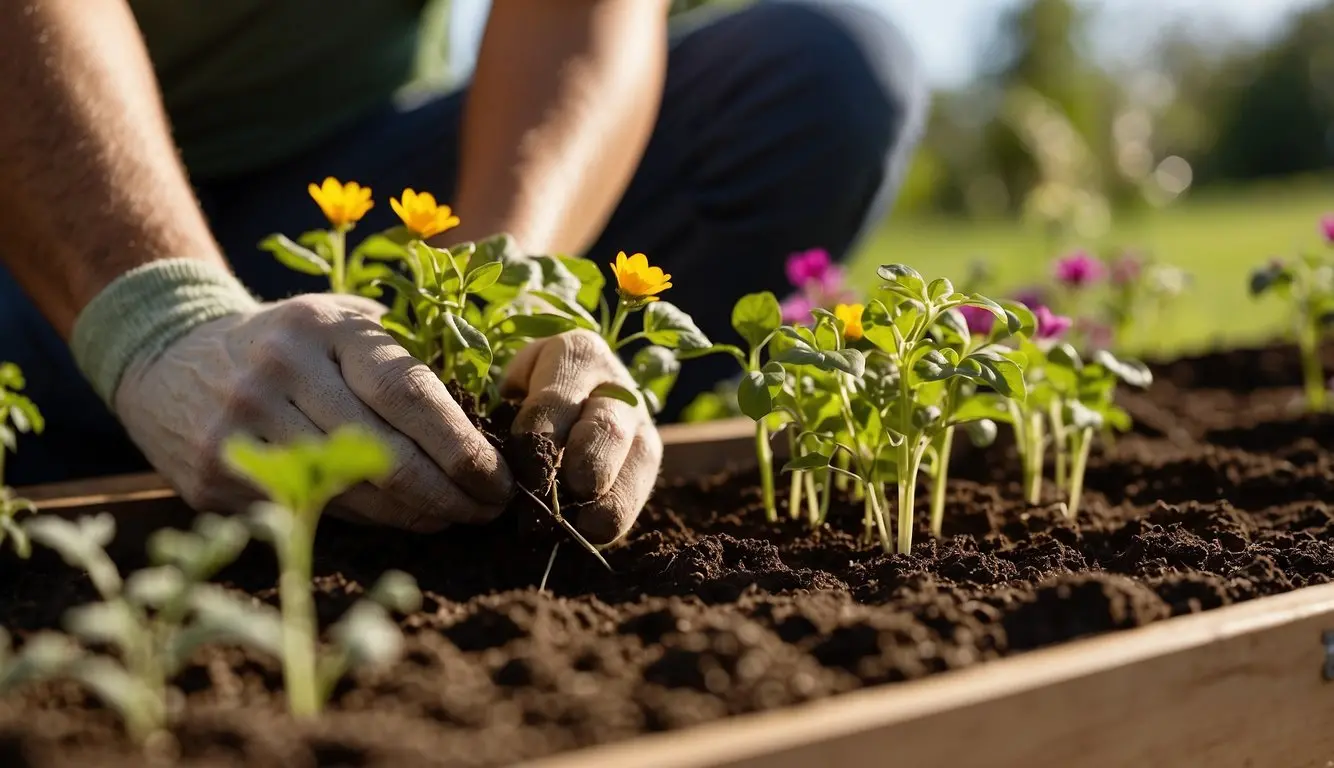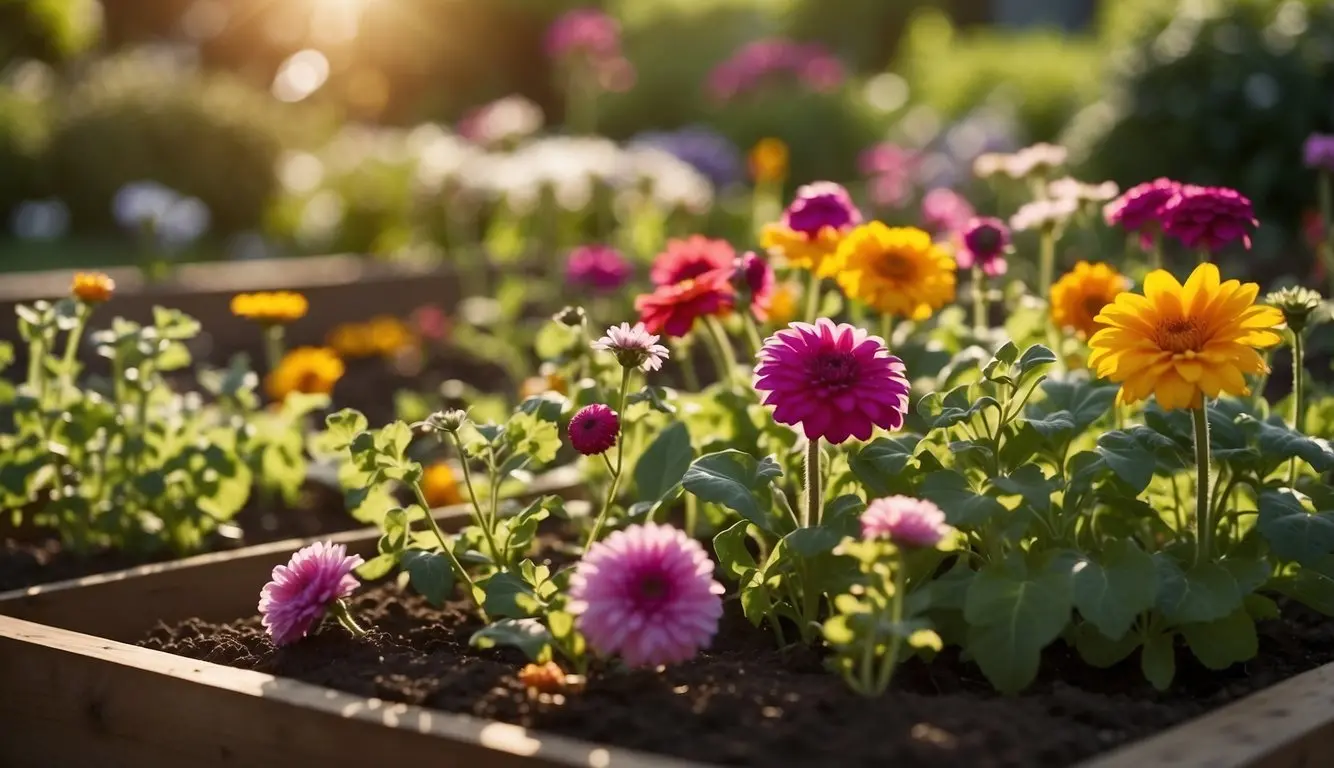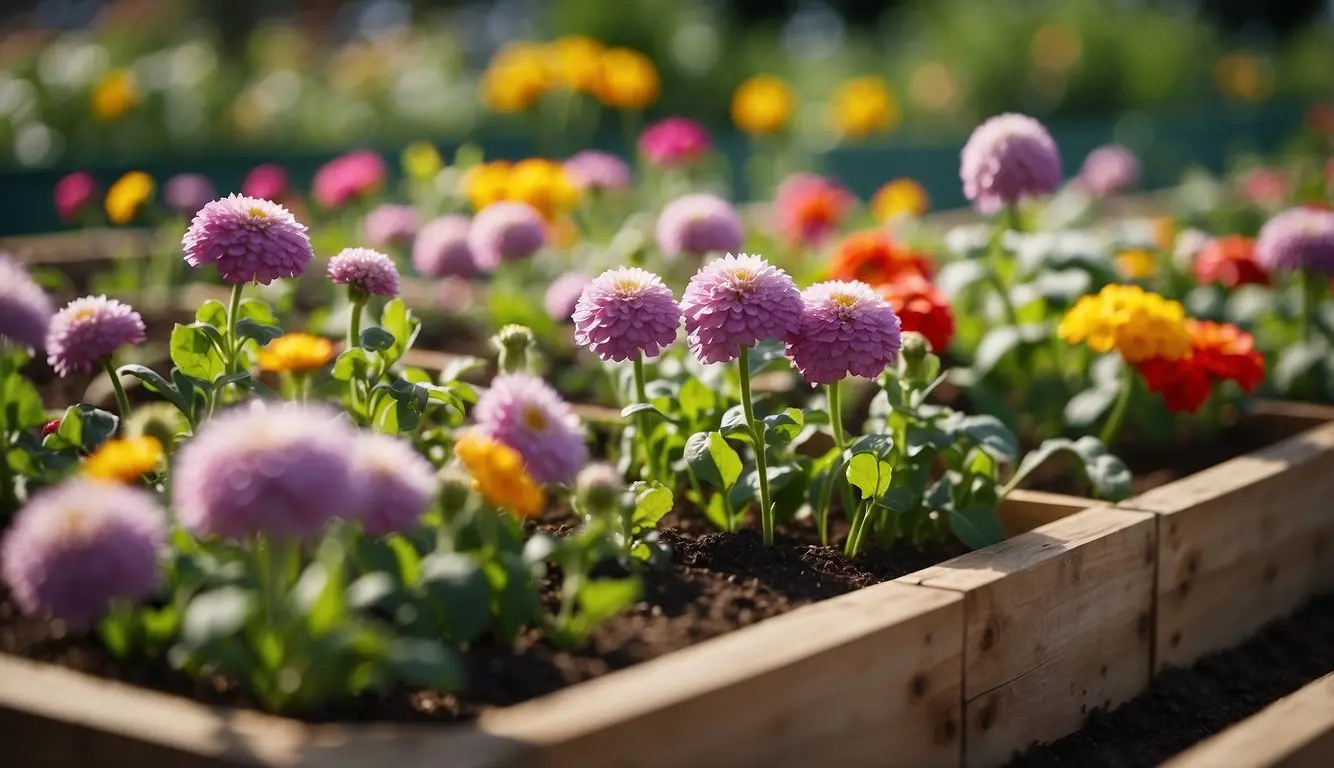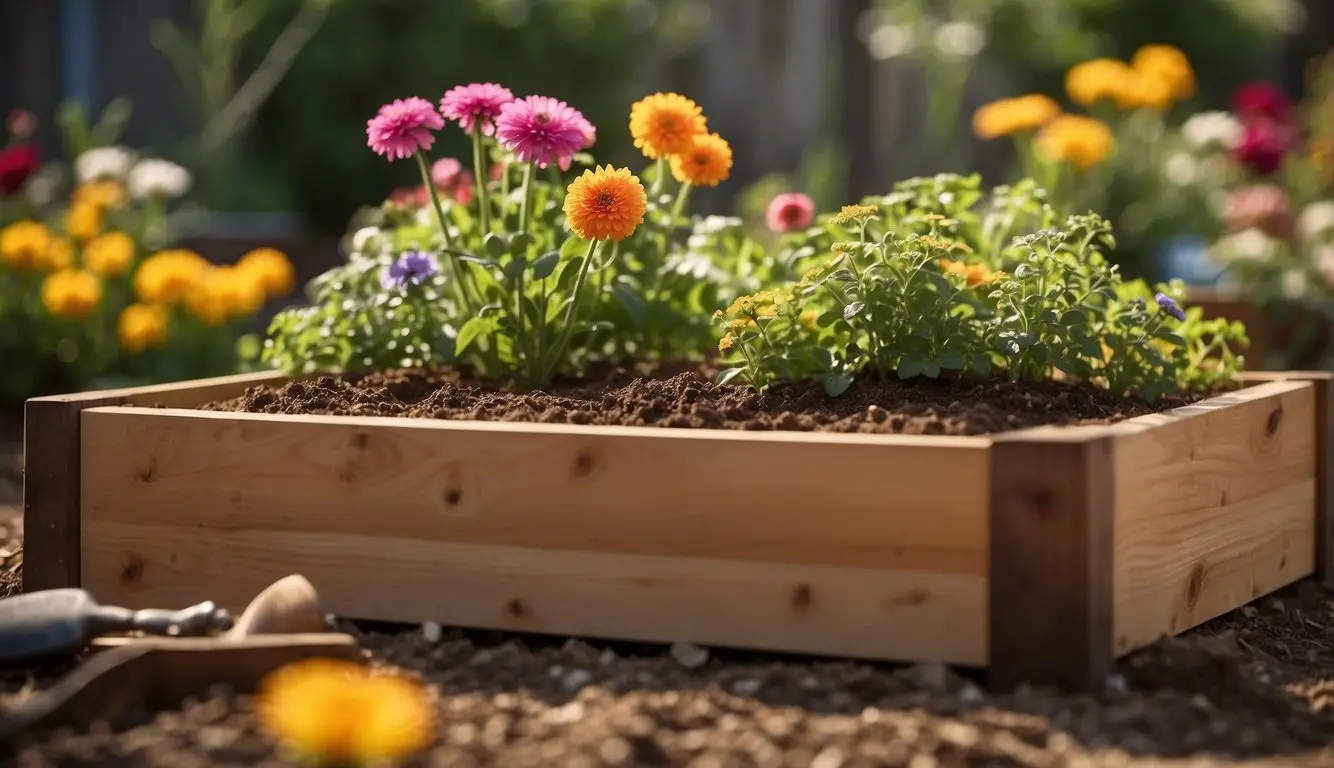Raised beds for flowers are a popular choice among gardeners, and for good reason. These types of beds offer numerous benefits, including improved soil quality, better drainage, and easier access for planting and maintenance. Whether you’re a seasoned gardener or a beginner, raised beds can be an excellent way to grow beautiful and healthy flowers.

One of the biggest advantages of raised beds is that they allow you to control the soil quality and composition. By adding organic matter and amendments to the soil, you can create an ideal growing environment that is rich in nutrients and well-draining. This can help your flowers thrive and produce more vibrant blooms. Additionally, raised beds can be easier to maintain than traditional garden beds, as they require less bending and kneeling.
If you’re interested in creating a raised flower bed, there are several factors to consider, including location, design, and soil preparation. By carefully selecting the right location and designing your bed to meet your specific needs, you can create a beautiful and functional garden that will provide you with years of enjoyment. With a little planning and effort, you can create a blooming success with raised beds for flowers.
Key Takeaways
- Raised beds offer numerous benefits for flower gardening, including improved soil quality and easier maintenance.
- Selecting the right location and designing your bed are important factors to consider when creating a raised flower bed.
- Proper soil preparation and planting techniques are essential for growing healthy and vibrant flowers in raised beds.
Table of Contents
Benefits of Raised Beds for Flower Gardening
If you’re looking to grow flowers in your garden, raised beds can offer several benefits over traditional in-ground gardening. Here are some of the top advantages of using raised beds for flower gardening:
Improved Soil Conditions
One of the primary benefits of raised beds is that you have complete control over the soil composition. You can add organic matter, compost, and other soil amendments to create the perfect growing medium for your flowers. This is especially important if you have poor soil quality in your yard. With raised beds, you can ensure that your flowers have access to the nutrients they need to thrive.
Enhanced Drainage
Another advantage of raised beds is that they provide excellent drainage. The soil in raised beds is elevated above ground level, which allows excess water to drain away more easily. This can help prevent waterlogging and root rot, which can be a common problem with in-ground flower gardens. In addition, raised beds can be designed with drainage systems, such as drainage pipes or gravel layers, to further improve water flow.
Pest and Weed Control
Raised beds can also help with pest and weed control. By elevating your flowers off the ground, you can make it more difficult for pests such as slugs and snails to reach them. You can also use physical barriers, such as row covers or netting, to protect your flowers from insects and birds. Raised beds can also help prevent weed growth, as you can add a weed barrier or mulch to the soil surface.
Ergonomic Advantages
Finally, raised beds offer ergonomic advantages that can make gardening more comfortable and enjoyable. By elevating the soil level, you can reduce the strain on your back and knees when planting, weeding, and harvesting. This can be especially beneficial for older gardeners or those with mobility issues. In addition, raised beds can be designed to be wheelchair accessible, making gardening accessible to everyone.
Overall, raised beds can be an excellent choice for flower gardening. With improved soil conditions, enhanced drainage, pest and weed control, and ergonomic advantages, you can create a beautiful and healthy flower garden with less effort and more success.
Selecting the Right Location
When it comes to selecting the right location for your raised flower bed, there are a few important factors to consider. In this section, we will explore two important aspects to keep in mind while selecting the location: sunlight and shade, and accessibility and aesthetics.
Considering Sunlight and Shade
The amount of sunlight your raised flower bed receives is crucial to the success of your flowers. Most flowering plants require at least six to eight hours of full sunlight per day to thrive. Therefore, it is important to choose a location that receives ample sunlight throughout the day. You can use a sun chart to determine which areas of your yard receive the most sunlight.
However, it is also important to consider the amount of shade in the area. If the location is too shaded, your flowers may not receive enough sunlight to grow properly. On the other hand, if the location is too sunny, your flowers may become dehydrated and wilt. Therefore, it is important to choose a location that receives a balance of sunlight and shade.
Accessibility and Aesthetics
Another important factor to consider while selecting the location is accessibility and aesthetics. You want to choose a location that is easily accessible for watering, pruning, and maintenance. Additionally, you want to choose a location that is aesthetically pleasing and will enhance the beauty of your yard.
Consider the level of the area where you want to place your raised flower bed. If the area is sloped, you may need to level it before constructing the raised bed. Also, consider the proximity to other features in your yard such as trees, shrubs, and other plants. You want to choose a location that complements the existing features of your yard.
In summary, selecting the right location is crucial to the success of your raised flower bed. Consider the amount of sunlight and shade, accessibility, and aesthetics while selecting the location. With a little planning and preparation, you can create a beautiful and thriving raised flower bed in your yard.
Designing Your Raised Flower Beds
Designing your raised garden beds is an exciting process that requires careful consideration of several factors. By choosing the right materials, shapes, and sizes, you can create a beautiful and functional garden space that will provide a blooming success.
Choosing Materials and Shapes
When selecting materials for your raised garden beds, consider the design style you want to achieve. Wood is a popular choice for its natural look and versatility. Cedar, redwood, and pine are all excellent options for their durability and resistance to rot and insects. Stone and rock are also great choices for a more rustic or natural look. They are durable and long-lasting but can be more expensive than wood.
In terms of shapes, raised garden beds can be rectangular, square, circular, or even irregular. Rectangular beds are the most common and practical, as they are easy to construct and provide a large planting area. Circular beds are great for creating a focal point in your garden, while irregular shapes can add visual interest and uniqueness to your garden design.
Sizing and Arranging for Unity
When it comes to sizing your raised garden beds, consider the available space in your garden and the types of plants you want to grow. You want to make sure that the bed is large enough to accommodate the plants you want to grow, but not so large that it becomes difficult to maintain. A good rule of thumb is to keep the width of your raised garden beds between 3 and 4 feet, and the length no more than 8 to 12 feet.
To create unity in your garden design, arrange your raised garden beds in a way that complements the overall look and feel of your garden. If you have a formal garden, consider arranging your beds in a symmetrical pattern. If you have a more natural or informal garden, arrange your beds in a more organic pattern.
By following these tips and considering the design, raised garden beds, materials, wood, rock, shapes, sizes, and unity, you can create a beautiful and functional garden space that will provide a blooming success.
Best Flowers for Raised Beds
If you’re looking to add some color and beauty to your raised beds, choosing the right flowers is key. Here are some tips to help you decide which flowers are best for your raised beds.
Perennials vs. Annuals
First, you’ll need to decide whether you want to plant perennials or annuals. Perennials are plants that come back year after year, while annuals only last for one growing season. Perennials can be a great investment, but they require more maintenance. Annuals are easier to care for, but you’ll need to replant them every year.
Some popular perennials for raised beds include:
- Coneflowers
- Black-eyed Susans
- Daylilies
- Coreopsis
- Salvia
Some popular annuals for raised beds include:
- Petunias
- Marigolds
- Zinnias
- Cosmos
- Sunflowers
Color Coordination and Seasonality
When choosing flowers for your raised beds, consider color coordination and seasonality. Choose flowers that complement each other and bloom at different times throughout the season to keep your garden looking vibrant and colorful.
For example, you could pair purple coneflowers with yellow black-eyed Susans for a striking color combination. Or, you could plant pink petunias with blue salvia for a softer look.
It’s also important to consider the amount of sunlight your raised beds receive. Some flowers, like petunias and marigolds, thrive in full sun, while others, like impatiens and begonias, prefer partial shade.
By following these tips, you can choose the best flowers for your raised beds and create a beautiful, blooming garden.
Soil Preparation and Amendments

If you want your raised bed for flowers to be a blooming success, then proper soil preparation and amendments are essential. Here are some tips to help you mix the perfect soil and choose the right organic matter and fertilizers.
Mixing the Perfect Soil
The first step in preparing the soil for a raised bed is to clear the debris and rocks. Then, you need to mix the soil to a depth of 8 to 12 inches for optimal root growth. You can use a garden fork or tiller to do this.
It is important to ensure that the soil is well-draining and has the right texture. You can test the soil pH to determine if you need to adjust it. A pH of 6.0 to 7.0 is ideal for most flowers.
To improve the soil texture, you can add organic matter such as compost, peat moss, or aged manure. These materials will also add nutrients to the soil. You can also add sand or vermiculite to improve drainage.
Organic Matter and Fertilizers
Organic matter is an essential component of the soil for a raised bed. It helps to improve soil structure, water retention, and nutrient availability. Compost is a great source of organic matter because it is rich in nutrients and beneficial microorganisms. You can make your own compost or buy it from a garden center.
Fertilizers are also important for the health and growth of your flowers. There are many types of fertilizers available, such as granular, liquid, and slow-release. It is important to choose a fertilizer that is appropriate for the type of flowers you are growing.
When selecting a fertilizer, look for one that contains nitrogen, phosphorus, and potassium (NPK) in balanced amounts. You can also choose a fertilizer that is specifically formulated for flowers. Be sure to follow the instructions on the label for application rates and frequency.
In summary, preparing the soil and adding organic matter and fertilizers are essential for a blooming success in a raised bed for flowers. By following these tips and using the right materials, you can create a healthy and productive garden.
Planting Techniques for Raised Flower Beds

When it comes to planting flowers in raised beds, there are a few techniques you can use to ensure your blooms thrive. In this section, we’ll cover spacing and depth, as well as layering for continuous bloom.
Spacing and Depth
One of the most important things to keep in mind when planting in raised beds is spacing. You want to make sure your plants have enough room to grow and thrive, but not so much space that they become crowded. As a general rule of thumb, most plants should be spaced about 6-12 inches apart.
When it comes to depth, you’ll want to make sure your plants are planted at the appropriate depth for their specific needs. Some plants, like petunias, should be planted at a depth of about 6-8 inches, while others, like marigolds, can be planted at a depth of 2-3 inches.
Layering for Continuous Bloom
To ensure your raised bed is always blooming, consider layering your plants. This means planting taller plants towards the back of the bed and shorter plants towards the front. This will create a visually appealing arrangement and ensure that there are always blooms to enjoy.
Another way to ensure continuous bloom is to deadhead your plants regularly. This means removing spent blooms to encourage new growth and prolong the blooming season. Be sure to also provide your plants with adequate sun and water to help them thrive.
In summary, when planting in raised beds, be mindful of spacing and depth, and consider layering your plants for continuous bloom. With these techniques, you’ll be well on your way to a blooming success.
Caring for Your Flower Garden

To keep your raised bed flower garden looking its best, there are a few important aspects of care to keep in mind. Here are some tips to help you care for your flower garden:
Watering and Mulching
Watering is an important aspect of caring for your flower garden. It is recommended to water your garden deeply once a week, rather than shallowly every day. This will encourage deeper roots and healthier plants. Make sure to water in the morning or evening to avoid evaporation during the heat of the day.
Mulching is another important aspect of caring for your flower garden. Mulch helps to retain moisture in the soil, suppress weeds, and regulate soil temperature. Apply a layer of organic mulch, such as shredded leaves or bark, around the base of your plants. This will also help to improve soil structure and fertility over time.
Pruning and Deadheading
Pruning and deadheading are important tasks to keep your flower garden looking its best. Deadheading is the process of removing spent flowers from your plants. This encourages the production of new blooms and helps to keep your plants looking tidy.
Pruning is the process of removing dead or damaged growth from your plants. This helps to promote healthy growth and can also improve the overall appearance of your plants. Make sure to use clean, sharp tools when pruning to avoid damaging your plants.
By following these tips for caring for your flower garden, you can help to ensure that your raised bed is a blooming success.
Attracting Pollinators and Companion Planting

If you want your raised bed flowers to thrive, attracting pollinators is essential. Pollinators like bees, butterflies, and flies help fertilize flowers, which leads to better fruit and seed production. Here are some strategies you can use to attract beneficial insects and birds to your raised flower beds.
Beneficial Insects and Birds
One of the best ways to attract pollinators to your raised flower beds is to create a diverse ecosystem that includes a variety of plants. Pollinators are attracted to flowers with bright colors and sweet nectar, so consider planting a mix of annuals and perennials like lavender, marigolds, and other herbs. These plants will not only attract pollinators but also help repel pests that can damage your flowers.
Another way to attract beneficial insects and birds is to provide them with a source of water. You can add a small water feature to your raised bed or simply place a shallow dish of water nearby. This will help keep your pollinators hydrated and happy.
Companion Planting Strategies
Companion planting is another way to attract pollinators and improve the health of your raised bed flowers. Companion planting involves planting two or more plants together that have a mutually beneficial relationship. For example, planting marigolds with your flowers can help repel pests and attract beneficial insects like ladybugs.
Another popular companion planting strategy is planting herbs like basil, dill, and parsley with your flowers. These herbs not only attract pollinators but also repel pests and improve soil quality. Plus, they are great for cooking!
In summary, attracting pollinators and using companion planting strategies are great ways to improve the health and productivity of your raised bed flowers. By creating a diverse ecosystem and planting a mix of plants, you can attract beneficial insects and birds that will help fertilize your flowers and keep pests at bay.
Protecting Your Blooms from Pests and Diseases

When it comes to gardening, dealing with pests and diseases is part of the package. However, with proper care and attention, you can minimize the damage they cause to your beautiful flowers in raised beds. In this section, we’ll cover some natural pest control methods and how to identify common flower diseases.
Natural Pest Control Methods
Chemical pesticides can be harmful to the environment and may not always be effective in controlling pests. Here are some natural methods you can try to keep pests at bay:
- Companion planting: Certain plants, such as marigolds, can repel pests and attract beneficial insects.
- Handpicking: If you spot pests on your flowers, remove them by hand and drop them into a bucket of soapy water.
- Neem oil: This natural oil can be used to control a variety of pests, including aphids and spider mites.
- Diatomaceous earth: This powder made from fossilized algae can be sprinkled on the soil to control pests like slugs and snails.
Identifying Common Flower Diseases
Keeping an eye out for common flower diseases can help you catch them early and prevent them from spreading. Here are some signs to look for:
- Powdery mildew: This fungal disease appears as a white powdery coating on leaves and stems.
- Botrytis blight: Also known as gray mold, this disease causes flowers to rot and turn brown.
- Rust: This fungal disease appears as orange-brown spots on leaves and stems.
If you notice any of these symptoms, remove the affected parts of the plant immediately and dispose of them in the trash. Avoid composting diseased plant material, as this can spread the disease to other plants.
In conclusion, taking care of your raised bed flowers requires attention to detail and proper care. By using natural pest control methods and identifying common flower diseases, you can keep your blooms healthy and thriving.
DIY Raised Bed Construction and Maintenance

If you’re looking for an easy way to add dimension and beauty to your garden, consider building your own raised flower beds. Raised beds are great for growing flowers, herbs, fruits, and vegetables and can be constructed from a variety of materials including wood and brick. In this section, we’ll cover everything you need to know about building and maintaining your own raised beds.
Building Your Own Raised Beds
When building your own raised beds, there are a few things to keep in mind. First, make sure to choose a location that receives plenty of sunlight and has good drainage. Next, decide on the material you want to use. Wood is a popular choice because it’s affordable and easy to work with. Cedar is a great option because it’s naturally resistant to rot and insects. Brick is another option that provides a more permanent and formal look.
Once you’ve chosen your material, it’s time to start building. Use a level to make sure your bed is even and add a layer of landscape fabric to prevent weeds from growing. Fill your bed with a high-quality soil mix and add compost to keep your plants healthy.
Seasonal Maintenance and Repairs
To keep your raised beds looking their best, it’s important to perform seasonal maintenance and repairs. In the fall, remove any dead plants and add a layer of compost or mulch to protect the soil from the cold. In the spring, add a layer of fresh compost and top off the soil if needed.
If you notice any damage to your raised beds, such as rotting wood or cracked bricks, make repairs as soon as possible. Replace any damaged materials and add a layer of sealant to protect the wood from moisture.
By following these tips, you can build and maintain beautiful raised beds that will add color and dimension to your garden for years to come.
Frequently Asked Questions

What are the best practices for designing a raised bed flower garden layout?
When designing a raised bed flower garden layout, it’s important to consider the size and shape of the bed, as well as the location and amount of sunlight it will receive. You should also consider the types of flowers you want to plant and how they will complement each other in terms of color, height, and bloom time. To maximize the space, consider planting taller flowers in the center and shorter flowers around the edges.
Which flowers are considered the easiest to grow in raised beds?
There are many flowers that are easy to grow in raised beds, including marigolds, zinnias, sunflowers, and cosmos. These flowers are low-maintenance and can thrive in a variety of soil conditions. They are also resistant to pests and diseases, making them ideal for beginner gardeners.
Can you recommend the best perennial flowers for growing in raised beds?
Perennial flowers are a great choice for raised beds because they come back year after year. Some of the best perennial flowers for raised beds include coneflowers, daylilies, black-eyed Susans, and daisies. These flowers are easy to grow, require little maintenance, and can add color and texture to your garden.
What are some low-maintenance plants suitable for raised flower beds?
If you’re looking for low-maintenance plants for your raised flower bed, consider succulents, herbs, or ornamental grasses. These plants require little water and can thrive in a variety of soil conditions. They also add texture and interest to your garden.
What should be considered when choosing plants for a raised bed in full sun?
When choosing plants for a raised bed in full sun, it’s important to choose plants that can tolerate heat and drought. Some good options include lavender, salvia, yarrow, and sedum. These plants have adapted to hot, dry conditions and can thrive in full sun.
What materials are recommended for the bottom layer of a raised flower bed?
The bottom layer of a raised flower bed should be filled with a layer of gravel or rocks to promote drainage. This will help prevent water from pooling at the bottom of the bed, which can lead to root rot and other problems. On top of the gravel, you should add a layer of landscape fabric to prevent weeds from growing up through the soil. Finally, add a layer of soil on top of the fabric to plant your flowers.
- Best Brush Cutter: Top 5 Models for Lawn Maintenance in 2024 - January 10, 2024
- Protecting Your Garden from Rodent Damage: Tips and Tricks - December 14, 2023
- Small Space Gardening: Transform Your Garden with Raised Beds - December 10, 2023
